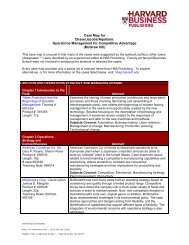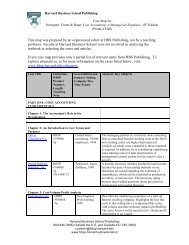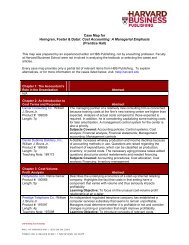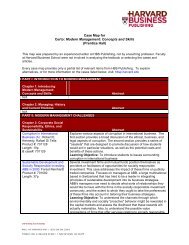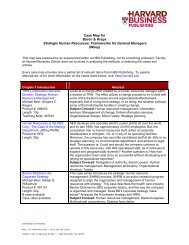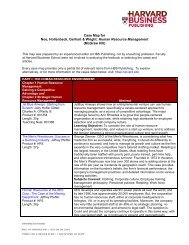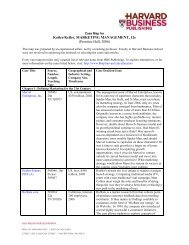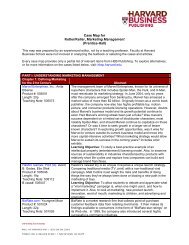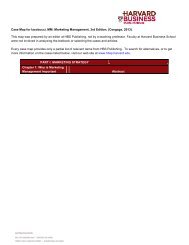Company Valuation Using Discounted Cash Flow
Company Valuation Using Discounted Cash Flow
Company Valuation Using Discounted Cash Flow
Create successful ePaper yourself
Turn your PDF publications into a flip-book with our unique Google optimized e-Paper software.
Alternative: Seagate<br />
Technology Buyout<br />
Supplement: <strong>Using</strong> APV: A<br />
Better Tool for Valuing<br />
Operations (HBR article)<br />
4. Capital <strong>Cash</strong> <strong>Flow</strong><br />
Berkshire Partners: Bidding<br />
for Carter’s<br />
Supplement: Note on Capital<br />
<strong>Cash</strong> <strong>Flow</strong> <strong>Valuation</strong><br />
(HBS background note)<br />
5. Equity <strong>Cash</strong> <strong>Flow</strong><br />
Andrade 201094 2001 19p 204160<br />
Luehrman 97306 1997 8p --<br />
Baker &<br />
Quinn<br />
205058 2005 14p 207029<br />
Ruback 295069 1994 13p --<br />
Acova Radiateurs Meulbroek 295150 1995 12p 200003<br />
Alternative: The Hertz<br />
Corporation (A)<br />
Supplement: Note on Valuing<br />
Equity <strong>Cash</strong> <strong>Flow</strong>s<br />
Luehrman &<br />
Scott<br />
208030 2007 18p 209068<br />
Luehrman 295085 1994 10p 295149<br />
II. Rationale for selecting and sequencing the items in this module<br />
Section 1 begins with the bestselling Harvard Business Review article “What’s It Worth? A General<br />
Manager’s Guide to <strong>Valuation</strong>”. The article first describes the limitations of the standard WACC (Weighted<br />
Average Cost of Capital) version of the DCF (<strong>Discounted</strong> <strong>Cash</strong> <strong>Flow</strong>) valuation of companies. As an<br />
alternative, the article then recommends the Adjusted Present Value, Real Options, and Equity <strong>Cash</strong><br />
<strong>Flow</strong> methods as better suited for valuing operations, opportunities, and ownership claims, respectively.<br />
The first supplement, “Note on <strong>Cash</strong> <strong>Flow</strong> <strong>Valuation</strong> Methods: Comparison of WACC, FTE, CCF and APV<br />
Approaches” (from Ivey), covers the same material at more length, and uses a capstone example to<br />
compare and contrast the various methods. The second supplement, the HBS note <strong>Valuation</strong> Methods<br />
and Discount Rate Issues: A Comprehensive Example reviews the various valuation methods and uses a<br />
simple example to demonstrate the consistency of their results under similar assumptions.<br />
Each of the subsequent sections highlights a particular valuation method, usually comparing it with one or<br />
more other methods. Section 2 compares the DCF valuation using WACC and the market multiples<br />
approaches. The HBP Briefcase, Mercury Athletic: Valuing the Opportunity, uses the potential acquisition<br />
of a footwear subsidiary to teach students DCF valuation using WACC, and compares the results with<br />
those drawn from market multiples approaches.The alternative is the Amtelecom Group Inc., a singlesession<br />
Ivey case, which explores the valuation of a Canadian telecommunications subsidiary either for<br />
sale to a buyer or for an initial public offering. In addition to valuing the subsidiary by DCF and market<br />
multiple methods, students are also asked to do a sum of parts valuation of the diversified firm. The<br />
supplementary technical note Corporate <strong>Valuation</strong> and Market Multiples reviews the implementation and<br />
limits of the market multiples method.<br />
Section 3 introduces Adjusted Present Value (APV). In the main selection, the HBP Briefcase <strong>Valuation</strong><br />
of AirThread Connections, students are required to value a potential acquisition, a regional cellular<br />
provider, with the WACC-based DCF method and with APV. They must choose which method to use<br />
when the capital structure is stable and when it is changing, and estimate the effect of capital structure<br />
changes on assumptions in determining beta and the cost of capital. The alternative, Seagate Technology<br />
Buyout, is a two-session case that concerns a leveraged buyout (LBO) of the disk drive operations of



